The Pain and Pleasure Principle
I don’t care much for pain. In fact, I’ll do almost anything to avoid it. I also know that pain can be a good thing.
The human nervous system triggers a sensation of pain to stop us from doing something that might cause a severe injury and to let us know that something may be wrong.
While we mostly think of pain in terms of physical well-being, I experience a certain amount of pain in parting with hard-earned money. It hurts. I hate the pain of payment. It takes away from the pleasure of the purchase.
Years ago, as I merrily made my way down the path of financial stupidity, I found two ways to avoid the pain of payment so I could fully enjoy the pleasure of purchase. It was like I’d discovered the ultimate way to have my cake and eat it too. I used credit cards. I wrote checks.
In my distorted way of thinking, paying with plastic or writing a check allowed me to enjoy the pleasure of the purchase absent the pain of payment. Payment by check meant to me that I got the goodies and the money was still there in my checkbook or my wallet. Oh, I knew that technically I’d spent it, but who wanted to be technical? It could take days, maybe even a week back then, for the money to really not be there. Pain delayed was pain denied — pleasure enjoyed.
Payment by credit card was even better because I could push the pain way into the future — far, far away.
Before long, having developed and practiced these painless purchasing methods, the very thought of mixing any pain of payment with a purchase seemed absurd and terribly unnecessary. Swiping a card or writing a check was more like a promise to pay later when it would be more convenient.
I was able to have the reward and enjoy the pleasure without any of the pain.
It was not unusual for me to come home from a shopping trip with all kinds of neat stuff and honestly announce that I’d not spent a dime. Pleasure without pain — it was a wonderful way to shop.
Deferring payment became so easy. I especially liked the fall months when all of my favorite department stores offered deferred billing. I could charge in October knowing the purchases would not be recorded until January.
I bought into that marketing scheme like nobody’s business! Don’t ask me what I thought would happen in January — how I would manage to explain all of this to my husband. There was always the chance that magically the money would just appear to pay off the charges even before the January statements showed up. Could happen, I’d tell myself.
The pleasure of purchasing with a complete absence of payment pain quickly became habit-forming. In fact, it was extra pleasurable because I could convince myself that I got away with something. It was totally exhilarating.
Of course, I knew that by delaying payments and agreeing to pay huge rates of interest in exchange for the privilege, the size of the eventual pain was increasing to near-catastrophic proportions. But through the magic of denial, I remained comfortably anesthetized.
I learned the hard way how painful the payment can be when there is no purchase pleasure to offset it. The pleasure is long gone, while the pain remains and intensifies over time.
There is a very important personal finance lesson in all of this and here it is:
The pleasure of the purchase needs to be counterbalanced by the pain of payment. When experienced this way, buying things does not become unrealistically pleasurable, and the pain of payment is not so terribly painful. The high and the low easily balance out. And should the pain outweigh the potential pleasure, no problem? You still have time to back out of the purchase — unlike the purchase where the pleasure and pain are so far removed they become completely unrelated.
For me, paying with cash is a security measure against experiencing unrealistic pleasure when buying things. Paying with cash forces me to experience the pain of payment at the same time I am enjoying the pleasure of purchase. It keeps things from spiraling out of control.
For those readers who have demonstrated the maturity necessary to effectively handle a credit card (meaning you faithfully pay the thing off every month and never incur interest on the account) and checking accounts (meaning that you never float a check or write against insufficient funds) try this:
When paying with a credit card, enter the amount of the purchase into your checkbook or electronic device and deduct it from the running balance just as if you’d handed over cold, hard cash. You spent the money. It’s gone. Accept it and move along.
This simple action will make sure that the pleasure doesn’t get out of control, nor is the payment unreasonably painful. It will keep your financial picture at all times realistic.
There’s something magical about writing things down. It’s pretty hard, if not foolish, to argue with facts.
The ability to step back from a spending situation and calculate the perceived pleasure to be gained against the pain of payment will be invaluable as you reshape your relationship with money.
I’ve pretty much made my peace with the pain of payment. In fact, I almost welcome it now because the discomfort forces me to remain alert as a cautious and conscious consumer — one who chooses to temper the pleasure of the purchase with the pain of payment.
Agree/Disagree with the author(s)? Let them know in the comments below and be heard by 10’s of thousands of CDN readers each day!




